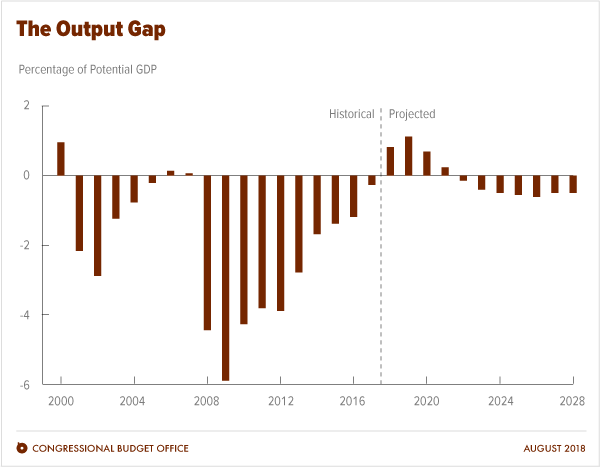An Update to the Economic Outlook: 2018 to 2028
View Document
August 14, 2018 - CBO regularly updates its economic forecast to incorporate changes in the agency’s methodology and to ensure that the projections reflect recent economic developments and current law. This report presents the agency’s latest  economic forecast, which includes the following key projections of real (inflation-adjusted) gross domestic product (GDP) and other factors:
economic forecast, which includes the following key projections of real (inflation-adjusted) gross domestic product (GDP) and other factors:
- In 2018, real GDP is projected to grow by 3.1 percent. That is about 0.6 percentage points faster than the pace of its growth in 2017 (see figure below). The pickup in growth is largely the result of increases in government spending, reductions in taxes, and faster growth in private investment. For the second half of the year, CBO expects real GDP to grow at roughly the same average pace as it grew in the first half of the year, which would represent a moderation following the 4.1 percent annualized growth of GDP reported in the second quarter. Such moderation occurs because several factors that boosted second-quarter growth— including a rebound in the growth of consumer spending from a weak first quarter and a surge in agricultural exports—are expected to either fade or reverse. In 2019, the pace of GDP growth slows to 2.4 percent in the agency’s forecast as growth in business investment and government purchases slows.

- Growth of actual output is expected to outpace the growth of its maximum sustainable amount through the rest of 2018 and 2019, creating excess demand in the economy. Although that growth in actual output leads to lower unemployment rates and higher income in CBO’s forecast, it also creates demand for goods, services, and labor that exceeds the economy’s long-run capacity to supply them.
- Excess demand will put upward pressure on prices, wages, and interest rates over the next few years. In CBO’s forecast, the growth of actual output slows markedly after 2019 because higher interest rates, along with the slower growth of federal outlays projected under current law, restrain demand. As the excess demand dissipates, the unemployment rate rises and inflation and interest rates fall. By 2022, the excess demand in the economy disappears.
- From 2023 to 2028, real GDP is projected to grow by about 1.7 percent each year. That is slightly slower than potential output grows, on average. (Potential output is CBO’s estimate of the maximum sustainable output of the economy.) The difference between actual and potential output arises because of a slight, temporary slowdown in the growth of actual output from 2025 to 2026, when some of the major provisions of the 2017 tax act (Public Law 115-97, originally called the Tax Cuts and Jobs Act) are scheduled to expire.

Although CBO’s current economic forecast does not differ significantly from the forecast that the agency published in April 2018, it nevertheless incorporates several important changes. For example, the current forecast is based on the path for discretionary spending specified in CBO’s most recent budget projections, which were released in May. That path includes less fiscal stimulus over the next few years than did the path that the agency used when it previously projected economic growth. That revision slightly lowered the agency’s projections of output growth and interest rates in the near term. Additionally, CBO has further revised downward its forecast of interest rates over much of the projection period on the basis of information about financial markets and the projections of other forecasters. It has also revised slightly upward its near-term inflation forecast on the basis of recent data on consumer prices.
The economic projections in this report do not differ significantly from those of other forecasters. They are slightly stronger in the near term than most of the forecasts by the private-sector economists who contributed to the July 2018 Blue Chip Economic Indicators. They are somewhat stronger in the near term and weaker in the long term than the latest forecasts by Federal Reserve officials.
Data and Supplemental Information
-
Data Underlying Figures
Source :CBO








